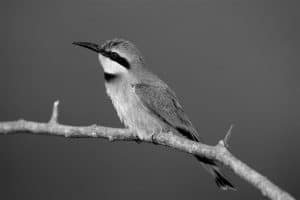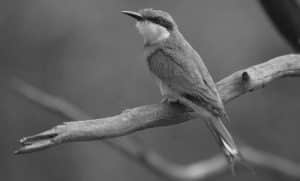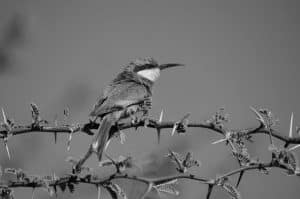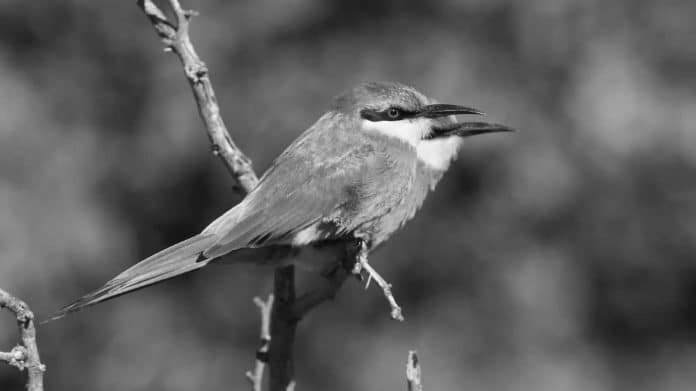Introduction to the Swallow-Tailed Bee-Eater
Welcome to the breathtaking world of the Swallow-Tailed Bee-Eater, an exquisite bird species that graces the open skies of Tanzania with its mesmerizing flight. With its striking plumage and graceful aerial displays, the Swallow-Tailed Bee-Eater in Tanzania is a sight to behold for bird enthusiasts and nature lovers alike. This magnificent avian species is known for its agility, vibrant colors, and unique feeding habits, making it a captivating subject for wildlife observation and photography.

The Swallow-Tailed Bee-Eater (Merops hirundineus) is a member of the bee-eater family, characterized by its elongated tail feathers, predominantly green plumage, and distinctive facial markings. These elegant birds are a common sight in the woodlands, savannas, and riverbanks of Tanzania, where they thrive in the abundance of insect life. Their aerial acrobatics and social behavior add to their allure, making them a popular attraction for bird-watchers and photographers seeking to witness their natural beauty in the wild.
Habitat and Behavior of the Swallow-Tailed Bee-Eater in Tanzania
In Tanzania, the Swallow-Tailed Bee-Eater is predominantly found in the eastern and northern regions, where it inhabits open woodlands, grasslands, and riverine areas. These diverse habitats provide the bee-eaters with an ample food supply, as they primarily feed on flying insects such as bees, wasps, and dragonflies. Their agile flight allows them to catch their prey on the wing, showcasing their remarkable hunting skills and adaptability to different ecosystems.
During the breeding season, Swallow-Tailed Bee-Eaters are known for their communal nesting behavior, where they excavate burrows in riverbanks or sandy cliffs to create their nesting chambers. These colonies can consist of several pairs of bee-eaters, adding to the spectacle of their presence in the wild. Their vibrant calls and aerial courtship displays further enhance the captivating experience of observing these birds in their natural habitat.
The Swallow-Tailed Bee-Eater’s migratory patterns also contribute to their significance in Tanzania, as they undertake seasonal movements to and from their breeding grounds, creating opportunities for bird enthusiasts to witness their impressive flights across the Tanzanian open skies.
The Swallow-Tailed Bee-Eater’s Unique Features
The Swallow-Tailed Bee-Eater is renowned for its striking visual attributes, making it a sought-after subject for photographers and bird-watchers. One of its most distinctive features is its elongated central tail feathers, which extend beyond the rest of its tail, giving it an elegant and graceful appearance in flight. The bird’s predominantly green plumage, complemented by a chestnut crown and throat, creates a visually stunning contrast that sets it apart from other avian species in the region.
Additionally, the Swallow-Tailed Bee-Eater’s facial markings, including a black eye stripe and a red patch above the eye, add to its charismatic appeal, making it a standout species in the avian kingdom. These unique features, combined with their aerial agility and social interactions, make the bee-eaters a captivating subject for observation and admiration in the wild.
The bee-eaters’ adaptation to their natural environment, particularly their foraging behavior and nesting habits, further exemplifies their unique characteristics and the vital role they play in the ecosystems of Tanzania.
Conservation Efforts for Swallow-Tailed Bee-Eaters in Tanzania

As with many wildlife species, the Swallow-Tailed Bee-Eater faces various conservation challenges, including habitat loss, human disturbance, and potential impacts from climate change. Recognizing the ecological importance and cultural significance of these birds, conservation organizations and local authorities in Tanzania have initiated efforts to protect and preserve the habitats crucial for the bee-eaters’ survival.
These conservation initiatives encompass habitat restoration, community engagement, and environmental education programs aimed at raising awareness about the significance of the Swallow-Tailed Bee-Eater and promoting sustainable practices for coexisting with these magnificent birds. By addressing the underlying threats and advocating for the conservation of the bee-eaters’ natural habitats, these efforts contribute to safeguarding the long-term viability of the species in Tanzania.
Furthermore, the involvement of local communities and stakeholders in conservation activities fosters a sense of stewardship and collective responsibility for protecting the Swallow-Tailed Bee-Eater and its habitats, ensuring a harmonious balance between human activities and the preservation of biodiversity in the region.
Bird-Watching Opportunities for Swallow-Tailed Bee-Eaters in Tanzania
Tanzania offers exceptional bird-watching opportunities for enthusiasts seeking to observe the Swallow-Tailed Bee-Eater in its natural environment. From the woodlands of the Eastern Arc Mountains to the riverine landscapes of the Rufiji River Basin, the diverse ecosystems of Tanzania provide ideal habitats for these graceful birds, allowing visitors to witness their captivating behavior and aerial displays.
For those seeking a unique avian adventure, the vast wilderness of Tanzania presents numerous opportunities to encounter the Swallow-Tailed Bee-Eater alongside a rich diversity of bird species. Whether exploring national parks, forest reserves, or wetland areas, bird-watchers can immerse themselves in the beauty of Tanzania’s avifauna while capturing memorable moments of the bee-eaters in flight or perched in their natural surroundings.
In addition to the thrill of spotting these magnificent birds, bird-watching tours and guided excursions in Tanzania offer valuable insights into the ecological interactions and conservation efforts related to the Swallow-Tailed Bee-Eater, enriching the overall experience with a deeper understanding of its significance in the local ecosystems.
The Swallow-Tailed Bee-Eater’s Role in Tanzanian Ecosystems
The Swallow-Tailed Bee-Eater plays a vital role in the ecosystems of Tanzania, contributing to the regulation of insect populations and the maintenance of ecological balance. As insectivorous birds, they help control the abundance of flying insects, including potential agricultural pests, thereby providing ecological services that benefit both natural habitats and human livelihoods.
Their nesting activities also influence the local landscape, as the excavation of nesting burrows contributes to the formation of exposed banks and cliffs, which in turn provide nesting sites for other species such as kingfishers and bee-eaters, fostering a complex web of ecological interactions and biodiversity in the region.
Furthermore, the presence of Swallow-Tailed Bee-Eaters in Tanzania’s ecosystems serves as an indicator of environmental health and habitat quality, reflecting the integrity of the natural landscapes and the sustainability of the interconnected ecological processes that support diverse forms of life.
Capturing the Flight of Swallow-Tailed Bee-Eaters in Tanzania: Photography Tips

For photographers eager to capture the graceful flight and vibrant colors of the Swallow-Tailed Bee-Eater, Tanzania offers a wealth of opportunities to hone their skills and create stunning avian imagery. Whether in flight, perched on branches, or engaged in social interactions, these birds present captivating subjects for photography, requiring an understanding of their behavior and the use of specialized techniques to achieve remarkable visual compositions.
When photographing Swallow-Tailed Bee-Eaters in their natural habitat, it is essential to consider the lighting conditions and background elements to enhance the visual impact of the images. The vibrant green plumage of the bee-eaters can be accentuated by natural sunlight, creating striking contrasts against the blue skies or lush vegetation, while capturing their aerial displays demands anticipation and quick reflexes to freeze the dynamic motions of their flight.
Patience and observation are key aspects of successful bird photography, as understanding the bee-eaters’ behavior and movement patterns allows photographers to anticipate their actions and position themselves for optimal compositions. Additionally, utilizing long lenses and maintaining a respectful distance from the subjects help minimize disturbance while enabling photographers to capture intimate details of the bee-eaters’ features and expressions.
Recommended Tours and Guides for Swallow-Tailed Bee-Eater Watching in Tanzania
Tanzania’s diverse landscapes and rich avian diversity make it an ideal destination for bird-watching enthusiasts eager to experience the beauty of the Swallow-Tailed Bee-Eater in its natural habitat. To maximize the potential for bird-watching encounters and gain insights into the ecology and behavior of these graceful birds, engaging the services of experienced guides and joining specialized bird-watching tours enhances the overall experience and facilitates meaningful connections with Tanzania’s avian wonders.
Numerous tour operators and local guides offer customized bird-watching itineraries that cater to the interests of bird enthusiasts and prioritize encounters with the Swallow-Tailed Bee-Eater and other notable avian species in Tanzania. These guided excursions often include visits to prime bird-watching locations, expert-led interpretations of bird behavior and ecology, and opportunities to immerse oneself in the natural splendor of Tanzania’s wilderness while appreciating the unique contributions of the bee-eaters to the local ecosystems.
By joining reputable bird-watching tours and engaging knowledgeable guides, visitors can gain valuable insights into the conservation efforts and ecological significance of the Swallow-Tailed Bee-Eater in Tanzania, fostering a deeper appreciation for the interconnectedness of avian life and the natural world.
Conclusion: Appreciating the Beauty of Swallow-Tailed Bee-Eaters in Tanzania
In conclusion, the Swallow-Tailed Bee-Eater stands as a symbol of natural beauty and ecological significance in the Tanzanian landscapes, captivating observers with its elegant flight, vibrant plumage, and communal behaviors. As ambassadors of the avian realm, these graceful birds enrich the ecosystems of Tanzania, contributing to insect control, landscape dynamics, and the cultural heritage of the region.
Through concerted conservation efforts, bird-watching opportunities, and photography experiences, the Swallow-Tailed Bee-Eater’s presence in Tanzania continues to inspire admiration and foster a deeper understanding of the interconnectedness between wildlife, habitats, and human interactions. By appreciating the beauty of the Swallow-Tailed Bee-Eater and recognizing its role in Tanzanian ecosystems, we celebrate the diversity of life and the enduring allure of nature’s winged wonders.


































